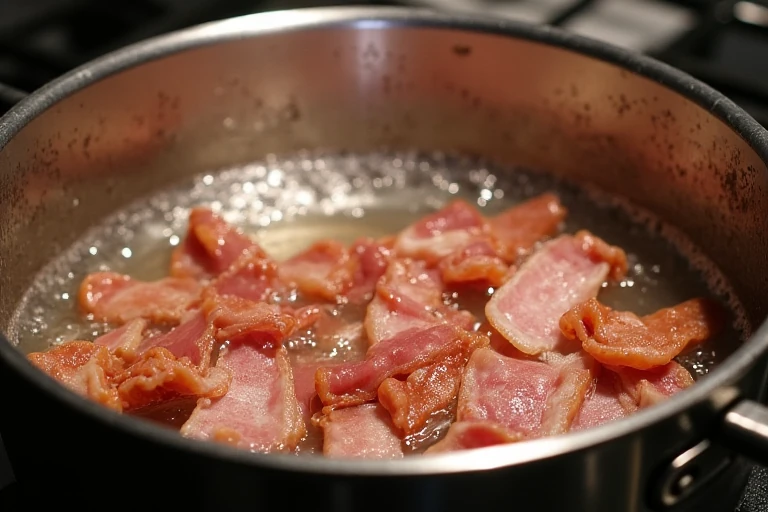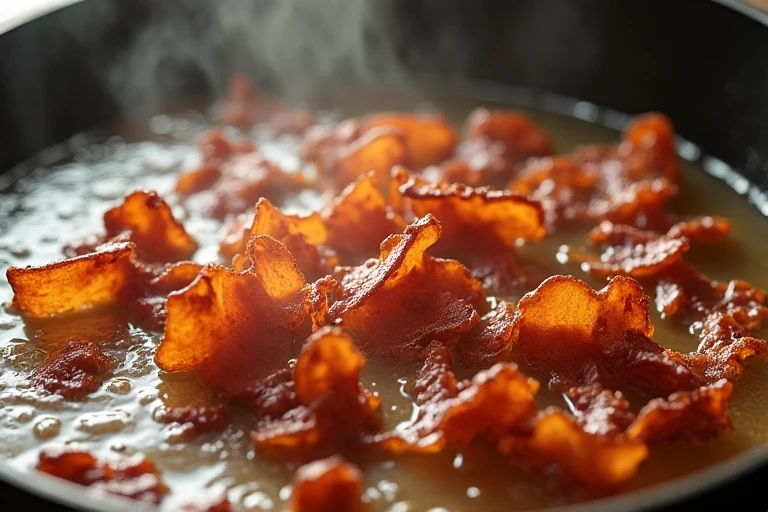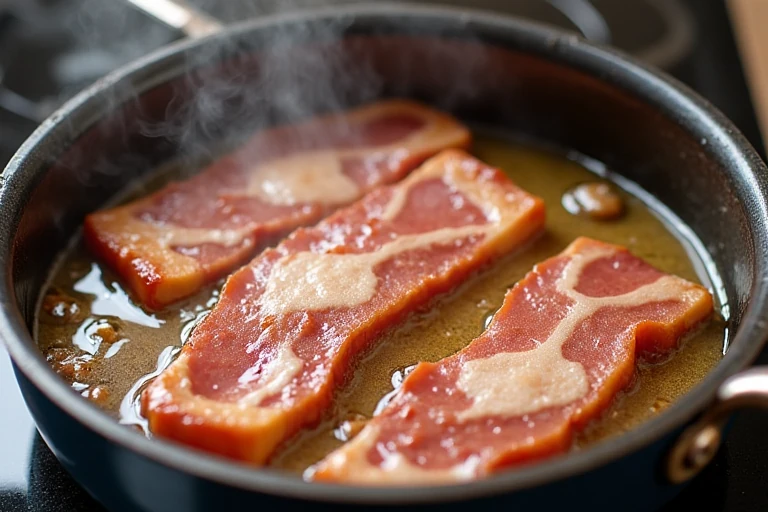Cooking bacon in water: Step-by-Step Recipe, Presentation, and Reasons Why It’s Beneficial

Imagine biting into a perfectly cooked strip of bacon — crispy, tender, and totally splatter-free. Envision effortlessly enjoying bacon without stressing about smoke, burned edges, or messy cleanup. Enter the magical realm of boiling bacon in water, where a clever trick turns ordinary pork belly into a melt-in-your-mouth delight. Join me on this enchanting journey as I reveal the secrets behind this ingenious hack, explaining exactly why cooking bacon in water yields incredible results every single time. Get ready to transform your morning ritual forever!
- Step-by-Step Guide to Cooking Bacon in Water
- Why You Should Cook Bacon in Water and Its Benefits
- What Seasonings Can You Add to the Water
- Optimal Cooking Time
- Optimal Temperature Regime
- Calories in Water-Cooked Bacon
- What Side Dish Goes Well with Water-Cooked Bacon?
- Several Varieties of Water-Cooked Bacon Recipes
Step-by-Step Guide to Cooking Bacon in Water
Want to make the absolute best bacon you’ve ever had? Follow my professional secrets below.
Required Ingredients and Equipment:
- Pork bacon (slices or full slab)
- Water
- Medium-sized pot
- Large skillet or non-stick pan
- Paper towels
Preparation Steps:
Step 1: Preparing the Water
Take a pot of adequate size and fill it with enough water to fully submerge the bacon. Better to err on the side of caution and use a little more water to allow space for boiling.
Step 2: Boiling the Bacon
Heat the water to a gentle boil over medium heat. Carefully drop the bacon into the simmering water, ensuring that it’s entirely submerged.
Pro Tip #1: Avoid crowding the pot. Work in small batches for optimal results.
Boil the bacon for about 3 minutes. During this process, the proteins will begin to firm up, releasing the fat. This step ensures that your bacon stays moist and doesn’t become dry.
Step 3: Draining the Water
After the specified time, carefully lift the bacon out of the pot and transfer it to a plate or board to drain off excess liquid.
Step 4: Crisping the Bacon
Time to give the bacon that irresistible crunch. Heat a large skillet or nonstick pan over medium heat. Fry the bacon slices one or two at a time, flipping them regularly until each side achieves a beautiful golden-brown color. This should take about 3–5 minutes, depending on the thickness of the strips.
Pro Tip #2: Keep a watchful eye on the stove temperature. Medium heat is ideal to avoid scorching or burning.
Step 5: Finishing Touches
Lay clean paper towels on a plate and place the cooked bacon atop them. Allow any residual fat to absorb. After a minute or two, transfer the bacon strips to a serving platter.
Benefits of This Method
- No messy splattering or unpleasant odors.
- Minimal effort for maximum enjoyment.
- Preserves the structure and flavor of the bacon perfectly.
Using the water-boiling method guarantees an amazingly delicious bacon that will delight you and your loved ones with its taste and appearance.

Why You Should Cook Bacon in Water and Its Benefits
Traditionally, bacon is fried in a pan, which causes inconvenience: splashing hot oil, unpleasant odor, constant monitoring required, and risk of uneven cooking. However, there’s an alternative method — cooking bacon in water, which offers numerous advantages.
Main Advantages:
- No Splashes or Mess. One major benefit is avoiding the splatters of hot oil characteristic of traditional frying. Everything goes smoothly and cleanly.
- Simplicity. There’s no need to worry about controlling the heat or constant stirring. All you need to do is place the bacon in boiling water and wait for it to cook.
- Time Savings. This method saves time, as after preliminary boiling, it takes mere minutes to achieve the desired crispness on a hot pan.
- Less Fat. Since most of the fat melts into the water during boiling, the resulting bacon becomes less fatty and therefore healthier.
- Perfect Balance Between Crunch and Moisture. Preliminary boiling helps retain moisture inside, preventing the bacon from becoming dry. As a result, you get the ideal texture — tender inside and crispy outside.
- Reduced Odor. During normal frying, bacon emits a strong, distinctive smell that lingers in the air. Boiling minimizes this problem.
- Safety. The process eliminates almost all risk of fire or accidental contact with hot oil on hands or clothes.
- Easy Cleanup. After boiling, you are left with clean utensils that are easily washed. There’s no oily residue on pots or pans that are difficult to clean.
How It Works:
The procedure is straightforward:
- Drop bacon strips into boiling water and cook for about 3 minutes.
- Remove the boiled bacon and lay it on paper towels to absorb excess moisture.
- Quickly sear it on a hot pan until it reaches the desired degree of crispness.
The result will be bacon with perfect structure, pleasingly moist and delicious.
Thus, cooking bacon in water is a simple, convenient, and useful method that allows you to obtain a high-quality product without hassle and risks associated with traditional frying.
What Seasonings Can You Add to the Water
- Garlic and Onion. Add whole garlic cloves and large chunks of onion directly to the boiling water. This will impart a subtle aroma and an additional flavor boost.
- Fresh Herbs. Try using thyme, rosemary, or sage. Their essential oils will gradually release into the water, enriching the bacon with new aromas.
- Spices. Cardamom, allspice, fennel seeds, or cloves can introduce intriguing flavor notes. Remember moderation to avoid overpowering the primary taste.
- Acidity. A dash of lemon juice or apple cider vinegar can add a faint tang, balancing the richness of the bacon.
- Sauces or Syrups. If you want to experiment, try adding a small amount of soy sauce or liquid honey. The taste will change dramatically, giving the bacon unique flavor notes.
Example Recipe with Added Seasonings:
- Bring water to a boil in a pot.
- Add your preferred seasonings and herbs (such as a couple of garlic cloves, a sprig of thyme, and a chunk of ginger root).
- Submerge the bacon in the boiling water and cook for 3–4 minutes.
- Continue as usual: pat dry and lightly fry in a pan until crispy.
Experimenting with different combinations will allow you to elevate your favorite dish to an entirely new level of flavor!
Optimal Cooking Time
The optimal cooking time for bacon in water is commonly accepted to be 3–4 minutes. This period is sufficient for the protein to solidify, partially extract fat, and still retain the juiciness and tenderness of the pork.
Factors Influencing Cooking Time
- Thickness of Strips: Thicker slices require longer cooking time. Thicker strips demand increased cooking time up to 4–5 minutes.
- Number of Strips: Cooking multiple strips simultaneously increases the cooking time by approximately 1–2 minutes.
- Water Temperature: Begin cooking in gently boiling water to minimize splattering and harmful substance release. Cooking duration also depends on the intensity of boiling: stronger boiling shortens the time but increases the risk of damaging the product.
Examples of Optimal Times
- Standard slices of medium thickness (around 3–4 mm): 3–4 minutes.
- Thicker slices (more than 5 mm): 4–5 minutes.
- Very thin slices (under 2 mm): 2–3 minutes.
Practical Advice
- Visually inspect the bacon: the strips will become springy, lose their softness, and noticeably firm up.
- Handle with care when removing bacon from boiling water; use tongs or a slotted spoon.
- Immediately after cooking, pat the strips dry with paper towels to eliminate excess moisture.
In summary, the optimal cooking time for bacon is 3–4 minutes, ensuring a tender, moderately dense, and perfectly cooked product.
Optimal Temperature Regime
The recommended temperature for boiling bacon in water ranges from 85–95°C (corresponding to a gentle simmer). This temperature range provides the following benefits:
- Effective protein coagulation, which gives the bacon its desirable density.
- Gradual removal of excess fat, preventing overly greasy results.
- Retention of sufficient moisture, ensuring juicy and tender strips.
It is important to avoid vigorous boiling, as aggressive bubbling negatively impacts the quality of the bacon, leading to loss of moisture and toughening.
Possible Deviations from Norm:
- Below 85°C: The bacon doesn’t cook adequately, potentially rendering it unsafe for consumption.
- Above 95°C: Risk of losing moisture increases, causing the bacon to become harder and less juicy.
Recommendations for Controlling Temperature
- Use an accurate kitchen thermometer to continuously monitor the temperature.
- Pre-heat the water to the recommended temperature before gently immersing the bacon.
- Maintain a steady, gentle simmer by regulating the heat intensity.
Thus, the optimal temperature regime for boiling bacon in water is 85–95°C, yielding a consistently well-prepared product with excellent structure and appealing taste.
Calories in Water-Cooked Bacon
Cooking bacon in water significantly influences its calorie content and nutrient composition. Let’s delve deeper into how the nutritional makeup changes and how energy values shift when using this cooking method.
Composition Changes Upon Boiling in Water:
- Fat Loss: The primary effect of boiling bacon in water is that a significant amount of fat dissolves into the water. The fat present in the raw product gets extracted, thereby reducing the overall calorie content.
- Protein Retention: Despite fat loss, most valuable proteins remain intact in the bacon, contributing to a complete nutritional profile.
- Calorie Count of the Finished Product: Typical calorie content of uncooked bacon ranges from 450–550 calories per 100 grams. However, after boiling in water, this figure decreases substantially. Average calorie content for boiled bacon falls within the range of 250–350 calories per 100 grams, depending on the initial thickness and fat content.

Additional Health Aspects:
- Elimination of the need for additional oil during frying reduces extra fat intake and eases digestive burden.
- Easier calorie tracking makes boiled bacon a great addition to weight-loss-oriented diets.
Summary:
Bacon cooked via boiling in water drastically reduces its calorie content, making it an excellent choice for individuals concerned about nutrition and health. Nevertheless, moderation is advised given the high sodium content and possible additives found in processed varieties.
What Side Dish Goes Well with Water-Cooked Bacon?
Choosing the right side dish for water-cooked bacon means highlighting its mild flavor and juiciness, complementing its aroma, and ensuring a harmonious combination of flavors. Here are some great side dish suggestions that pair excellently with water-cooked bacon:
Best Side Dish Options for Water-Cooked Bacon:
- Fresh Vegetable Salad. Light salads with green leaves, cucumber, radishes, or avocado create a contrast with the salty taste of bacon, providing a refreshing sensation.
- Potato Mash. Soft mashed potatoes with milk and butter complement the neutral flavor of bacon, smoothing out the feeling of heaviness.
- Green Peas or Broccoli. Bright green peas or broccoli revitalize the taste experience, balancing the heaviness of bacon.
- Crispy Crackers or Toasts. Simple whole-grain crackers or toasted baguettes with a light brush of oil add enjoyable texture and merge harmoniously with the tenderness of bacon.
- Grilled Vegetables. Soft eggplants, sweet peppers, or zucchini, slightly grilled, provide an interesting complement to water-cooked bacon.
- Buckwheat Groats or Rice. Buckwheat or fluffy rice act as excellent neutral companions, emphasizing the richness of bacon’s flavor.
- Fresh Fruit. Vibrant fruits like apples, pears, or grapes create an unexpected flavor pairing that works well with bacon.
Key Points for Choosing a Side Dish:
- Select light, natural components that enhance rather than overshadow the main course.
- Play with different textures: soft elements intensify perception of crispiness, while crunchy items complement smoother textures.
- Experiment with various vegetables and grains to find the perfect harmony of flavors.
These ideas will help you compose a fantastic menu, supplementing your water-cooked bacon with original and interesting side dishes.
Several Varieties of Water-Cooked Bacon Recipes
Cooking bacon in water has gained popularity among health-conscious people and fans of quick and easy meals. Here are several tried-and-tested, simple recipes that maximize the benefits and enjoyment of cooking bacon in water.
1. Classic Boiled Bacon Recipe
Ingredients:
- Bacon (slices or whole strip);
- Water.
Steps:
- Bring water to a boil in a deep pot.
- Place bacon slices in boiling water.
- Simmer gently for about 3–4 minutes until the bacon becomes firm and opaque.
- Remove bacon from water, pat dry with paper towel, and serve.
Features: Effortless preparation with minimal effort leads to a tender, nearly diet-friendly bacon.
2. Bacon with Herbs and Spices
Ingredients:
- Bacon (slices);
- Water;
- Freshly ground black pepper;
- Rosemary or thyme;
- Garlic cloves.
Steps:
- Bring water to a boil.
- Add rosemary leaves, crushed garlic cloves, and black pepper to the boiling water.
- Put bacon slices into the water and cook for 3–4 minutes.
- Drain and pat dry with paper towels.
Features: Infusion of aromatic herbs and spices adds extra flavor and aroma while keeping the dish low in calories.
3. Lemony Bacon
Ingredients:
- Bacon (slices);
- Water;
- Lemon juice (juice of half a lemon).
Steps:
- Heat water to boiling point.
- Stir in lemon juice into the boiling water.
- Submerge bacon slices in the water and cook for 3–4 minutes.
- Take out, pat dry, and serve.
Features: The tang of lemon counters the fattening nature of bacon, lending a refined taste.
4. Soy-Sweet Bacon
Ingredients:
- Bacon (slices);
- Water;
- Soy sauce;
- Brown sugar.
Steps:
- Bring water to a boil.
- Dissolve a small spoonful of brown sugar and a tablespoon of soy sauce in the boiling water.
- Add bacon slices to the water and cook for 3–4 minutes.
- Pat dry and serve.
Features: Combining soy sauce and brown sugar creates a unique sweet-and-spicy flavor that distinguishes this recipe.

5. Hot Breakfast with Poached Egg and Boiled Bacon
Ingredients:
- Bacon (slices);
- Water;
- Eggs;
- White vinegar.
Steps:
- Boil water and add bacon slices. Cook for 3–4 minutes.
- Meanwhile, separately bring water to a boil, adding a little vinegar. Swirl the water with a spoon and gently slide the egg into the center. Cook poached egg for 3–4 minutes.
- Place the cooked bacon on plates and top with poached eggs.
Features: A great quick breakfast option blending the delicate taste of eggs with tender, boiled bacon.
Why cook bacon in water?
Cooking bacon in water helps render out excess fat, leaving the bacon tender and less greasy. Additionally, it eliminates splattering and the risk of burning.
Doesn’t boiling destroy the taste of bacon?
Not at all. By boiling bacon, you actually enhance its texture and prevent it from becoming overly crispy or dry. Plus, you can season the water for added flavor.
What kind of bacon is best suited for this method?
Thinner slices of bacon work best. Thicker cuts might need longer cooking times to achieve the same results.
How long should I boil the bacon?Answer: Three to four minutes is usually sufficient. You want the bacon to be firm but not rubbery.
Can I reuse the water after boiling bacon?
Yes, you can save the water for making stocks or sauces. It’s packed with rendered fat and flavor.
Do I need to add anything else to the water?
You can season the water with herbs, spices, or liquids like soy sauce or lemon juice to infuse extra flavor into the bacon.
Won’t boiling make the bacon soggy?
No, if you follow the right cooking time and drain the bacon properly afterwards, it won’t become soggy. Instead, it’ll stay moist and tender.
Is it okay to eat bacon straight after boiling?
Absolutely. Some people prefer eating it as-is, while others opt to finish it off in a pan for extra crispness.
I heard boiling removes the fat. Will it still be unhealthy?
Although boiling reduces fat content, bacon inherently contains saturated fats. Consumption should still be moderated regardless of the cooking method.
Wouldn’t boiling bacon make it bland?
Boiling alone won’t dull the flavor. You can enhance it by seasoning the water or finishing the bacon in a pan with spices.
My bacon looks pale after boiling. What’s going on?
That’s normal. Boiling removes some of the surface coloring but preserves the natural pinkish tone beneath. You can restore color by briefly frying it afterwards.
Will boiling make the bacon less crispy?
Boiling itself won’t make the bacon crispy. But you can achieve that by finishing it in a hot pan or oven after boiling.
I’m worried about germs surviving in boiled bacon. Is it safe?
As long as you cook the bacon to an internal temperature of 165°F (74°C), it will be safe to consume.
What are some creative uses for boiled bacon?
You can incorporate it into salads, pasta dishes, sandwiches, or even desserts like chocolate-dipped bacon.
Any tips for perfecting the technique?
Don’t overcrowd the pot, use a timer to avoid overcooking, and always drain and pat dry the bacon before serving or further cooking.